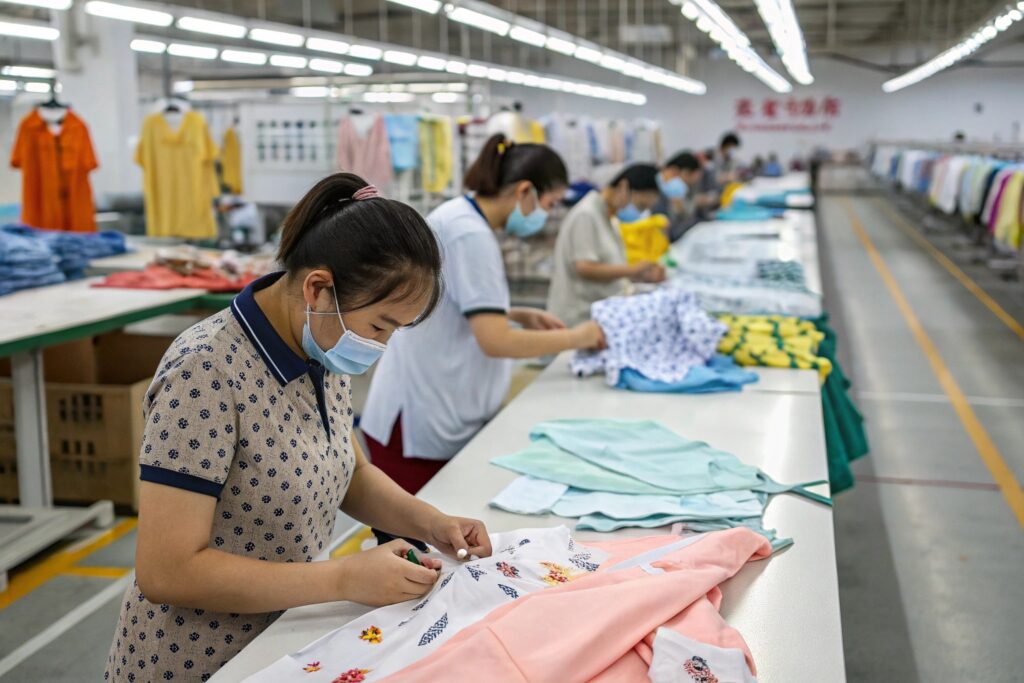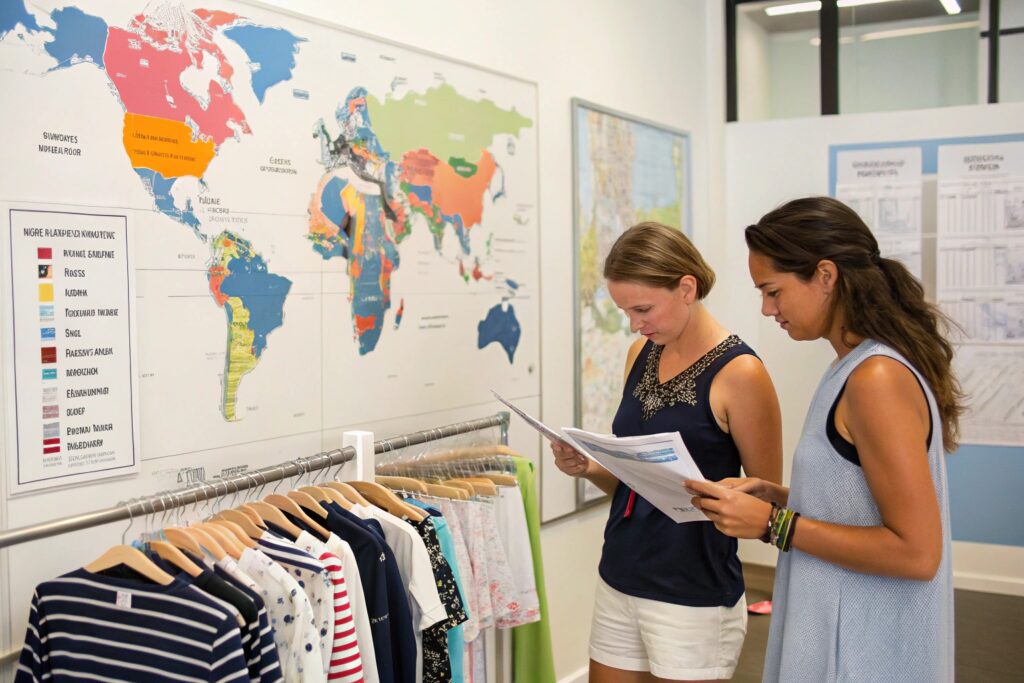Trying to run the same capsule drop globally? That’s a common mistake. What works in California may flop in Scandinavia.
To succeed globally, capsule collections must be tailored region by region—considering local style, season, and sales rhythm.
I’ve worked with brands launching in both hot and cold markets at once. The secret isn’t more designs—it’s smarter planning, segmented production, and localized strategies.
Adapting Capsule Designs to Regional Style Preferences?
What looks cute in Paris might not sell in Texas. Regional preferences aren’t minor—they’re make-or-break factors.
You need to adapt capsule collections to reflect regional aesthetics, colors, cultural icons, and seasonal relevance to boost sell-through.

How can brands modify capsule pieces without redesigning entire collections?
Start with a base silhouette—say, a girls’ A-line dress. Then build region-specific variations. For Northern markets, use darker palettes, long sleeves, and muted trims. For tropical markets, go sleeveless with floral prints. The shape stays the same, but the regional styling transforms the product.
At Fumao Clothing, we help clients build “modular” capsules like this. One client produced a base set of joggers and adjusted the waistbands, prints, and material thickness for four different markets. This allowed them to stay visually consistent as a brand while serving localized preferences.
We also help clients apply cultural insight. For example, certain motifs (like dragons, stars, or fruits) hold different connotations in various regions. Our regional design consultants help match motifs with market taste. It’s these subtle shifts that turn a 60% sell-through rate into a 90% one.
Why do capsule drops fail in some countries but succeed in others—and how can you predict this?
Capsules often fail when brands assume “one style fits all.” They use feedback from one test market and apply it globally. But factors like religious holidays, school start dates, or even fabric acceptability can differ dramatically by region.
For example, leggings with crop tops may thrive in Southern U.S. states but underperform in more conservative European markets. A fleece hoodie may trend in Germany during October but be irrelevant in Australia, where it’s springtime.
To avoid these mismatches, we always advise clients to run pilot drops in multiple regions, gather data, and adapt. Fumao offers A/B test production, so buyers can launch region-specific SKUs side-by-side to compare performance.
Managing Production Timelines for Global Markets?
Running capsule drops in several regions at once can feel like juggling flaming swords.
You need staggered, localized production schedules to meet different market needs without overloading your supply chain.

How should buyers plan production calendars when dealing with multiple seasonal timelines?
You can't use one calendar. Instead, build staggered capsule production plans that align with each market’s retail calendar. Here’s a rough breakdown we help clients use:
| Region | Capsule Season | Production Start | Delivery Target |
|---|---|---|---|
| North America | Back-to-school | May | July |
| Middle East | Ramadan | Jan | March |
| Europe | Winter Capsule | Aug | Oct |
| Australia | Summer Capsule | Sept | Nov |
This staggered timeline helps you avoid factory overload and shipping bottlenecks. At Fumao, we reserve line capacity for key seasonal cycles per region. That way, your orders don’t compete with each other for slot time.
And we offer overlapping production slots. So while your spring capsule is in sewing for the U.S., we’re cutting for your Middle East Ramadan collection. This workflow avoids bottlenecks and ensures timely drops.
What’s the risk of centralized production timelines, and how do we avoid it?
Centralized timelines mean treating all markets the same. That works for basics—but not for capsules. You’ll either ship too early (and kill shelf life) or too late (and miss peak demand).
We once had a buyer who insisted on a global drop in April. That meant woolen kidswear reached Dubai in 90°F heat. It flopped. The same line sold out in Berlin. That was a lesson in localization.
Fumao helps clients avoid this with production mapping. We segment their capsule timelines and tag each order by region, climate, and launch date. Then we assign them to production lines that match the sequence. It’s manufacturing with a calendar—not chaos.
Balancing Inventory Across Diverse Climate Zones?
Hot and cold regions buy differently. But splitting inventory evenly isn’t the solution.
Smart capsule planning means allocating inventory based on local climate demand, not global averages.

How can brands balance capsule inventory when launching across warm and cold zones simultaneously?
Split your inventory by need, not equality. A client recently launched a kidswear capsule with both fleece joggers and cotton tees. They allocated 70% joggers to Canada and 30% to Mexico—and did the reverse for tees. Both regions sold out.
Here's a simplified table for capsule climate planning:
| Climate Zone | Preferred Fabrics | Ideal SKUs | Capsule Weight |
|---|---|---|---|
| Cold | Fleece, knits | Hoodies, joggers | 65–75% |
| Warm | Jersey, cotton | Tees, shorts | 25–35% |
| Transitional | Blends | Layered sets | 50–50% |
We also advise clients to pre-position SKUs. For colder zones, we ship earlier to account for weather swings. For tropical markets, we favor smaller lots and frequent restocks. It’s about agility, not volume.
What’s the best way to avoid dead stock in climate-mismatched regions?
Dead stock usually comes from poor planning, not bad product. You sent sweaters to a warm region in October? Of course they won’t sell.
Capsules let you test before going all-in. At Fumao, we help brands start with micro-capsules—200–300 units per style per region. We track sell-through by climate and adapt reorders weekly.
This helps you avoid markdowns. If a warm region underperforms on a heavier style, we shift stock to a cooler zone using cross-dock logistics. It’s not just about making clothes—it’s about moving them where they’ll sell.
Regional Trend Forecasting for Smarter Capsule Planning?
Guesswork doesn’t work. Smart capsules begin with smart data.
Regional trend forecasting ensures your capsule lines match local demand—down to the print, fabric, and colorway.

How do brands use regional data to plan smarter capsule designs?
They use trend platforms, sales reports, and direct consumer feedback. But data alone isn’t enough—it has to be filtered through local context.
We help clients use:
- Google Trends by region
- Alibaba and Amazon bestsellers
- Local social media influencers
- Regional sales history
A butterfly print trending in New York may not move in Milan. A muted pastel may fly in Tokyo but stall in Florida. Regional forecast data turns assumptions into insight.
Our in-house trend team gives capsule buyers market-specific predictions every quarter. We map trend patterns like “retro cartoon prints” or “neutral tones for toddlers” and cross-check them against region-specific feedback. That gives you an edge before the first sample is even cut.
What forecasting mistakes do brands make when planning international capsules?
Here are the top three:
- Globalizing a local hit. A great seller in one region isn’t guaranteed to work elsewhere.
- Ignoring cultural sensitivities. Certain colors, phrases, or prints may be off-limits in specific cultures.
- Chasing global macro-trends. Micro-trends drive capsule success. That means local TikTok stars matter more than global runway shows.
At Fumao, we build forecast-informed capsules with our buyers. From print selection to fabric sourcing, we use predictive models tailored by region. The result? You launch the right product, in the right place, at the right time.
Conclusion
Planning capsule collections across regions isn’t about more designs—it’s about smarter timing, targeted trends, and local market logic. Do that, and your capsules will sell everywhere they land.










